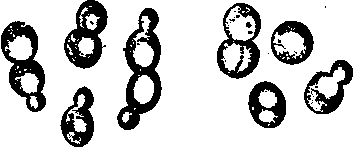The Process Of Alcoholic Fermentation
Description
This section is from the book "The Human Body: An Elementary Text-Book Of Anatomy, Physiology, And Hygiene", by H. Newell Martin. Also available from Amazon: The Human Body.
The Process Of Alcoholic Fermentation
The Process Of Alcoholic Fermentation may be illustrated by brewing. To make beer, brewers usually commence with barley, which contains much starch. Yeast will not act directly on starch, so the grain is kept moist and warm until it sprouts; during this process the greater part of the starch is turned into sugar ready to nourish the young plant. Before the plant uses the sugar the grain is heated until it is killed: the product is known as malt. The malt is crushed, and the sugar and some other things dissolved out by water; this solution is beerwort, a sweetish liquid.
Name some real use of alcohol. Describe the yeast plant. How is it that dilute sugar solutions exposed to the air are apt to undergo alcoholic fermentation ? How is malt made? Why is barley malted before used for brewing ? What is wort ? How made ?

Yeast Plants: magnified greatly (about 800 diameters).
To this the brewer adds yeast, and very soon a remarkable series of phenomena occurs. Bubbles of gas are given off abundantly, so that the whole liquid becomes frothy; this gas is carbon dioxide, useless to animals either as food or for breathing. As the fermentation proceeds, there is less gas because most of the sugar has been destroyed and the yeast has little more to break up, but alcohol has accumulated in the liquid. Hops and other flavoring matters may have been added to the wort during its fermentation, but this does not essentially influence the process, which is the destruction of sugar and the formation of alcohol and carbon dioxide, under the influence of the yeast fungus.
When the sugar of the wort is almost destroyed, we find the bubbling of gas to nearly cease. The sweet-tasting wort has lost its sweetness, the yeast settles to the bottom of the vessel, and the product is the intoxicating liquid known as beer, and containing alcohol instead of the original sugar. During the fermentation good food has been destroyed and a dangerous liquor has been produced.
Some Other Alcoholic Fermentations
The fermentation of barley wort by yeast is but one example of many similar cases. The juices of most fruits and vegetables contain a sugar capable of alcoholic fermentation. As the fruits ripen the germs of various alcoholic ferments collect upon their surfaces and stems, from whence they are easily carried into the juice as it is pressed out. They may also be found in a dry state floating about in the air in the vicinity of ripening fruits : but they are never found in the juice itself while it is in the fruit. Hence alcoholic fermentation never starts in the interior of fruits with unbroken skins.
What are the essentials in the process of brewing? How is the wort changed when the fermentation is nearly completed ? Why are most vegetable and fruit juices fermentable ?
When the juice of apples is pressed out and exposed to the air, ferments from the surface of the fruit, or floating in the dust of the air, reach it, and break up its sugar into carbon dioxide and alcohol; the result is cider, an intoxicating liquor. Similarly with pear-juice, which when fermented gives perry. In like manner, the ferments that rest upon the skins and stems of grapes are easily carried into the fermenting vats* when the grape-juice is exposed, and seizing upon the sugar, produce the alcohol-containing liquor called wine. Wines are also made from other fruits, such as currants, raspberries, elderberries, etc. It is important to remember in this connection that the character of a substance does not depend upon its quantity, but upon its quality. All beers, ales, porters, ciders, and wines (home-made or not) contain alcohol in varying quantity, but the character of the alcohol is in every case the same.
Continue to:
